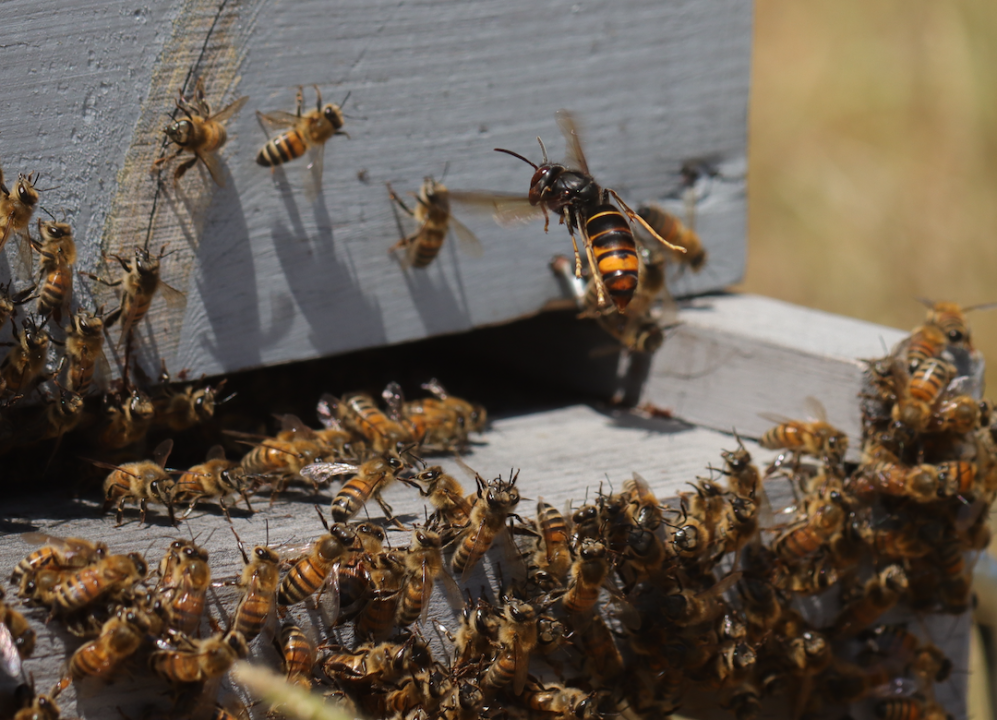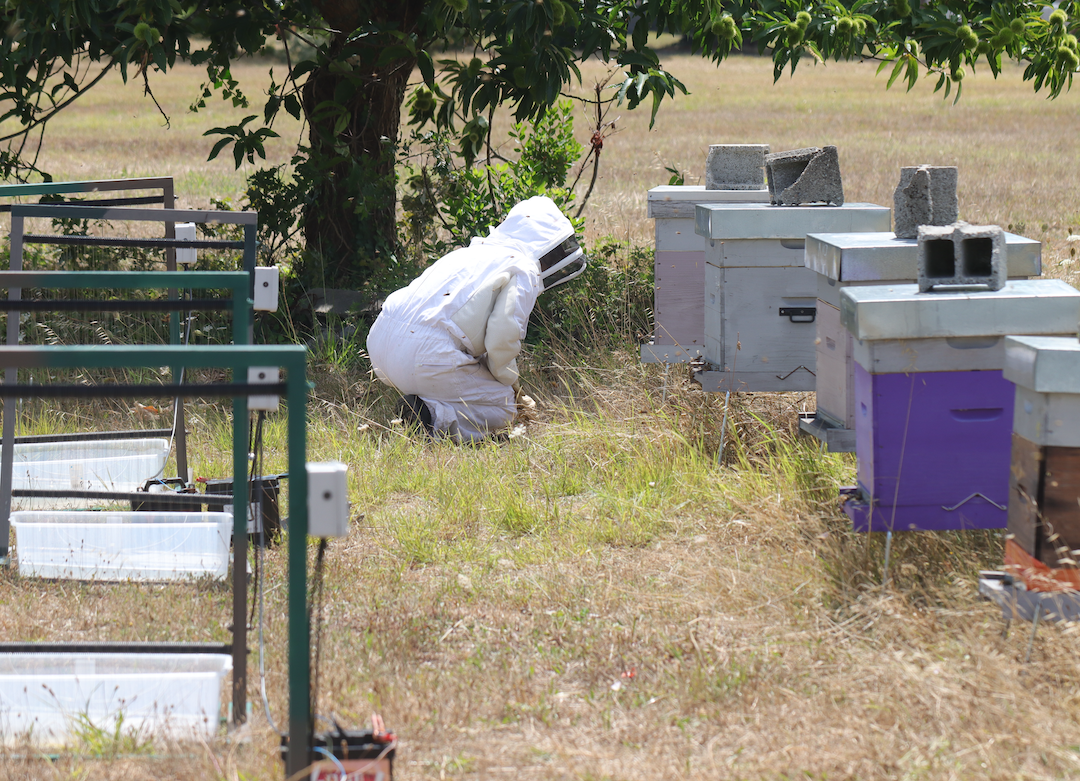
By 2021, Michel Costa had become a frustrated veteran of an obscure yet devastating war in Europe. The enemy: invasive Asian hornets, which had been massacring his honey bees by the thousand. Costa had fought the invaders on the outskirts of Bordeaux, France, swatting them with an electric racket as they hovered outside his hives. He had taken the battle to the trees, crystallizing them by injecting their nests with a chemical disinfectant. And he had fought them from the ground, blasting the highest of their nests into oblivion with a troop of local hunters armed with shotguns. But whatever Costa and his comrades tried, the hornets kept coming.
So that year, when Costa, a retiree and avid beekeeper, discovered a new weapon with the potential to change the course of the entire war, he was intrigued. Several companies had begun selling so-called "electric harps," which they claimed could kill the hornets in droves by electrocuting them as they flew through. When a nearby apiary reported problems with a swarm of them, he leapt at the opportunity to test one, placing it on top of a bin where hornets had gathered. Costa then watched in awe as the harp killed "hundreds" of them, one by one, within minutes. "The demonstration of its effectiveness was staggering," he says.
As Reasons to be Cheerful reports, until that day, Costa and many other European beekeepers had struggled to find any efficient means of repelling the hornets' attacks. Asian hornets first arrived in France from China in 2004, having hitched a ride in a shipping crate. Back in their Asian homeland, they predate a diverse diet of other creatures, including honey bees. The honey bees indigenous to those territories have evolved strategies to evade the marauding hornets over time. But the hornets' invasion of Europe caught local honey bees defenseless. According to one estimate, an Asian hornet can decapitate, dismember and feed the vulnerable European honey bees to their larvae at a rate of 30 per day.
The hornets have been causing chaos in apiaries across western Europe, penetrating deeper into the continent every year. First France fell, then Spain, Portugal, Italy, Britain, Austria, Germany, Belgium and others. One scientific analysis estimated that up to 29 percent of France's bee colonies could collapse every year as a result. Other countries came to similar conclusions. This not only increases the cost of honey production, but also places entire ecosystems at risk as a result of the reduced pollination activity, in which honey bees play a significant part. And this threat is no longer contained within Europe. In August 2023, scientists confirmed that Asian hornets had flown into U.S. airspace for the first time.
Because European honey bees are unable to protect themselves, beekeepers and scientists have, over the past couple of decades, been experimenting with different means of defending them. They tried trapping the queen hornets, hunting the hornets' nests and protecting the honey bees' hives with special "muzzles" that prevented the hornets from entering. But whatever they tried, the solution proved unsustainable (because of expense or time), ineffective or unacceptably harmful to other animal species.
Even concerted, organized attempts to search for and destroy the nests have proven unsuccessful in eliminating the hornets, according to French entomologist Denis Thiéry, one of the first to start studying them. "Even if you trap 20 queens," he says, "it is like a drop of water in the sea."

It's unclear exactly who developed the initial idea for electric harps, but the earliest mention of it online is in a blog post by a French beekeeper, published in 2015 — several years before Costa first discovered them. The concept remained relatively unknown for a while, but as scientists have produced more research that supports claims of their efficacy, more European beekeepers have adopted them. According to a recent survey of beekeepers across southwest Europe, 16 percent now use them.
Although the harps take different forms, each one is made of some sort of large frame, which is then "strung" with conductive metal wires. These are then connected to a source of electricity, often solar panels, so that the wires conduct simultaneously positive and negative charges. When a hornet flies through, its wings touch the wires on either side, completing a circuit, and thereby delivering a fatal current of electricity. Beekeepers then place the harps around their hives in positions along the hornets' frequent flight paths.
Thiéry and other scientists have found that hives protected by harps fare better than those without. Honey bees need to be able to collect enough food throughout summers to survive the subsequent winters. Any hives in areas where hornets are present suffer as their workers neglect foraging duties out of fear. "This is terrible for the hives," Thiéry says. His and other scientists' research has shown that the harps can reduce predation pressure by 89 percent — enough to give hives the chance to replenish their stores. In one study only 56 percent of unprotected hives survived through winter, while 78 percent of those protected by harps did.
One crucial benefit is the harps' specificity in targeting Asian hornets. Their metal wires are spaced about two centimeters apart, which is wide enough for a bee to fly through unharmed — but not a hornet. Because of these selective dimensions, the harps offer a means of killing hornets that is better for biodiversity than other methods. A 2023 study by a group of Spanish scientists found that 91 percent of the insects that the harps killed were Asian hornets. Only one percent were domesticated honey bees.
Harps are also cheaper than other methods for beekeepers to install and operate. Beekeepers can buy them in complete kits that cost around $300 from commercial suppliers online, as Costa did. When combined with solar panels, maintenance costs are minimal. This is important for any defensive measures because beekeepers, depending on the country they live in, receive no or limited central government funding to protect their hives (although Thiéry hopes that this will change in France in the near future).
Thiéry and Costa, who have become close friends in the face of a mutual enemy, are now trying to teach other beekeepers how to construct their own harps with cheap, accessible materials. Thiéry describes this as an easy process, which can cost as little as $160. The two enthusiasts hosted a workshop for 10 other beekeepers from their region earlier this year. They shared blueprints for a "DIY" model that they designed themselves and recommended suppliers for the materials.
While the electric harps offer a promising new weapon, Thiéry admits that no existing tool can end the war. After seeing the hornets' rapid rate of spread across Europe, he believes that it's now impossible to eradicate them (not all of his peers agree with this). But in combination with "search and destroy" programs targeting hornet nests, beekeepers can use ensembles of electric harps to protect their bees from the worst harm. "It is the solution," Costa says.
This story was produced by Reasons to be Cheerful and reviewed and distributed by Stacker Media.